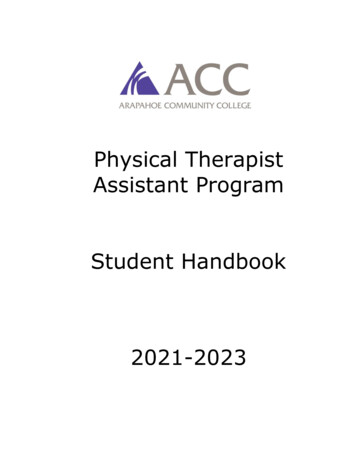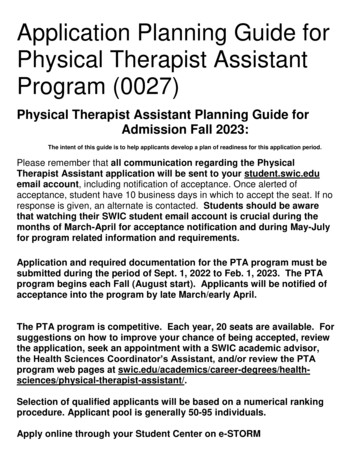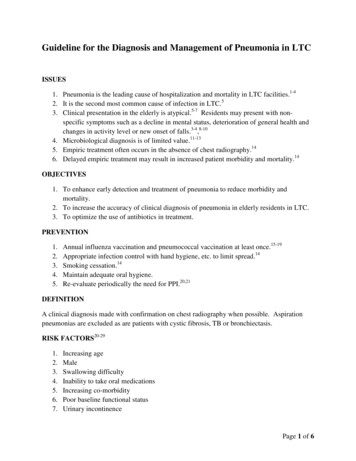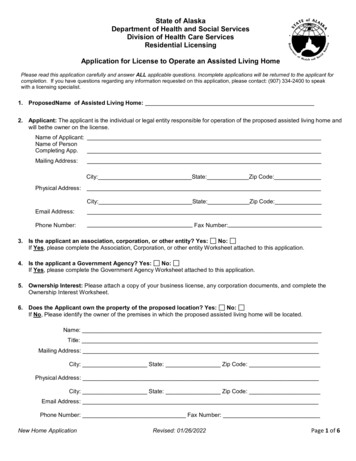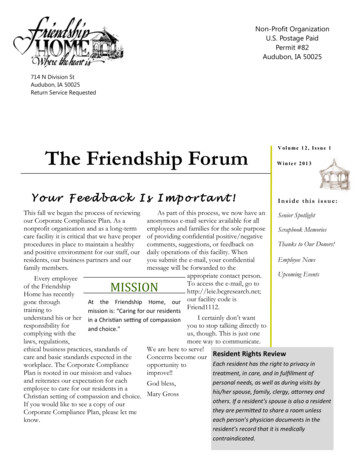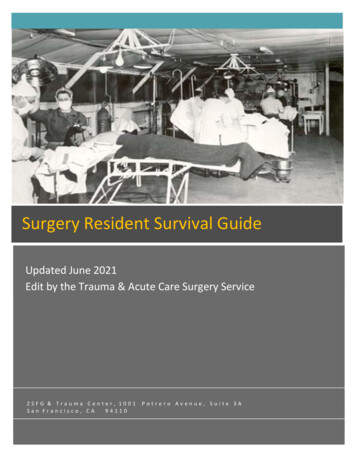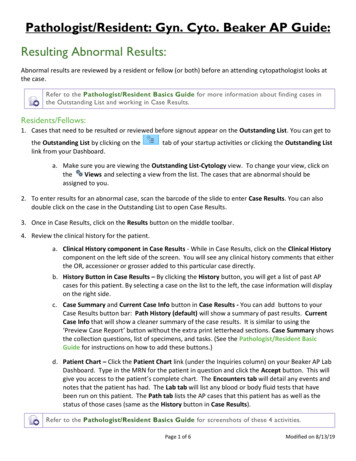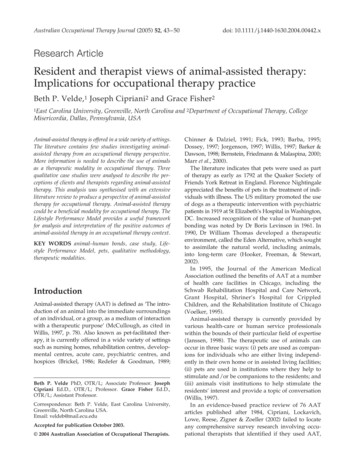
Transcription
Australian Occupational Therapy Journal (2005) 52, 43–50Research herapyAsia PtyJournalLtddoi: P. VeldeandArticleet al.therapist viewsResident and therapist views of animal-assisted therapy:Implications for occupational therapy practiceBeth P. Velde,1 Joseph Cipriani2 and Grace Fisher21EastCarolina University, Greenville, North Carolina and 2Department of Occupational Therapy, CollegeMisericordia, Dallas, Pennsylvania, USAAnimal-assisted therapy is offered in a wide variety of settings.The literature contains few studies investigating animalassisted therapy from an occupational therapy perspective.More information is needed to describe the use of animalsas a therapeutic modality in occupational therapy. Threequalitative case studies were analysed to describe the perceptions of clients and therapists regarding animal-assistedtherapy. This analysis was synthesised with an extensiveliterature review to produce a perspective of animal-assistedtherapy for occupational therapy. Animal-assisted therapycould be a beneficial modality for occupational therapy. TheLifestyle Performance Model provides a useful frameworkfor analysis and interpretation of the positive outcomes ofanimal-assisted therapy in an occupational therapy context.KEY WORDS animal–human bonds, case study, Lifestyle Performance Model, pets, qualitative methodology,therapeutic modalities.IntroductionAnimal-assisted therapy (AAT) is defined as ‘The introduction of an animal into the immediate surroundingsof an individual, or a group, as a medium of interactionwith a therapeutic purpose’ (McCullough, as cited inWillis, 1997, p. 78). Also known as pet-facilitated therapy, it is currently offered in a wide variety of settingssuch as nursing homes, rehabilitation centres, developmental centres, acute care, psychiatric centres, andhospices (Brickel, 1986; Redefer & Goodman, 1989;Beth P. Velde PhD, OTR/L; Associate Professor. JosephCipriani Ed.D., OTR/L; Professor. Grace Fisher Ed.D.,OTR/L; Assistant Professor.Correspondence: Beth P. Velde, East Carolina University,Greenville, North Carolina USA.Email: veldeb@mail.ecu.eduAccepted for publication October 2003. 2004 Australian Association of Occupational Therapists.Chinner & Dalziel, 1991; Fick, 1993; Barba, 1995;Dossey, 1997; Jorgenson, 1997; Willis, 1997; Barker &Dawson, 1998; Bernstein, Friedmann & Malaspina, 2000;Marr et al., 2000).The literature indicates that pets were used as partof therapy as early as 1792 at the Quaker Society ofFriends York Retreat in England. Florence Nightingaleappreciated the benefits of pets in the treatment of individuals with illness. The US military promoted the useof dogs as a therapeutic intervention with psychiatricpatients in 1919 at St Elizabeth’s Hospital in Washington,DC. Increased recognition of the value of human–petbonding was noted by Dr Boris Levinson in 1961. In1990, Dr William Thomas developed a therapeuticenvironment, called the Eden Alternative, which soughtto assimilate the natural world, including animals,into long-term care (Hooker, Freeman, & Stewart,2002).In 1995, the Journal of the American MedicalAssociation outlined the benefits of AAT at a numberof health care facilities in Chicago, including theSchwab Rehabilitation Hospital and Care Network,Grant Hospital, Shriner’s Hospital for CrippledChildren, and the Rehabilitation Institute of Chicago(Voelker, 1995).Animal-assisted therapy is currently provided byvarious health-care or human service professionalswithin the bounds of their particular field of expertise(Janssen, 1998). The therapeutic use of animals canoccur in three basic ways: (i) pets are used as companions for individuals who are either living independently in their own home or in assisted living facilities;(ii) pets are used in institutions where they help tostimulate and/or be companions to the residents; and(iii) animals visit institutions to help stimulate theresidents’ interest and provide a topic of conversation(Willis, 1997).In an evidence-based practice review of 76 AATarticles published after 1984, Cipriani, Lockavich,Lowe, Reese, Zigner & Zoeller (2002) failed to locateany comprehensive survey research involving occupational therapists that identified if they used AAT,
44or their perceptions of the potential use of AAT intheir practice. One survey using a non-randomsampling of occupational therapists who currently orhistorically used AAT in their practice was limited bya 33% response rate (n 30) (Casey, 1996). Conferenceproceedings covering the same time period, andanecdotal evidence suggests occupational therapistsare demonstrating growing involvement in the provision of AAT.Benefits of animal-assisted therapyStudies of the human-companion animal bond revealmany physiological and psychological benefits. Petting adog with which one is bonded to promotes relaxation,characterised by decreased blood pressure and increasesin peripheral skin temperature (Baun, Oetting &Bergstrom, 1991). A report by Connor and Miller (2000)on the use of pet visitation in a critical-care medicalsetting suggested that AAT had a calming influence onpatients, and advocated the use of AAT to increasepatient cognition, range of motion, strength, and balance.Nurses have used AAT in the perioperative settingto decrease preoperative anxiety, improve patientpositive outlook, and reduce the need for preoperativemedication (Miller & Ingram, 2000). Animal-assistedtherapy may be helpful in reducing fear and anxiety inpatients with a psychiatric condition prior to receivingelectroconvulsive therapy (Barker, Pandurangi, & Best,2003). There are also positive reports of the use AAT inhelping individuals with spinal cord injury (Counsell,Abran & Gilbert, 1997). A recent occupational therapystudy found that senior citizens in a walking programat an assisted living facility walked further when witha dog than when they walked alone, indicating thepotential value of pets in physical conditioning(Herbert & Greene, 2001).Animals fulfil emotional needs when considered acompanion or partner (Rosenkoetter, 1991). Furthermore, relationships with animals can facilitate learning, provide comfort, promote a sense of safety andimprove self-esteem (Rosenkoetter). An individual withtype 1 diabetes reported that her Jack Russell terrierwould awaken her at night by licking her face whenthe woman’s blood sugar levels had fallen to dangerously low levels. The woman was convinced that herdog sensed her discomfort and was reacting to this(C. S. Daniels, 2003, personal communication).Although results were inconclusive, findings on thepositive behavioural outcomes of AAT were suggestedin a quantitative investigation conducted at a residential program for children with multiple disabilities(Heimlich, 2001). Pets have also been used therapeutically with children and adolescents in a psychiatricfacility (Banman, 1995). A study of children in a paediatric cardiology inpatient unit demonstrated thatB. P. VELDE ET AL.AAT can reduce stress and improve morale (Wu, Niedra,Pendergast, & McCrindle, 2002). A recent investigation of pet ownership by Allen, Kellegrew and Jaffe(2000) in persons with HIV or AIDS showed pets canprovide emotional support and a reason to perseverethrough a serious illness.Zissleman, Rovner, Shmuely and Ferrie (1996) foundthat AAT decreased irritable behaviours in patientswith mental illness, although they did not find statistically significant treatment differences among a groupof gero-psychiatric inpatients when comparing anexercise program to a pet therapy program. Variablesincluded self-care, disoriented behaviours, depressedor anxious mood, irritable behaviours and withdrawnbehaviours. When a ‘pets as therapy’ program wasconducted over a 12-week period with a group ofchronic ward-bound patients with dementia, Walsh,Mertin, Verlander and Pollard (1995) reported a substantial drop of noise levels in the living quartersfor the experimental group, as well as a statisticallysignificant drop in heart rate of the residents.Phear (1997) described positive client attitudestowards visiting dogs in a day hospice in England.Chinner and Dalziel (1991) examined attitudinal, behavioural, and interactive changes as exhibited byterminally ill residents and their caregivers when a dogwas introduced as a resident in the hospice. Animalassisted therapy increased patient–staff interaction,eased patient-visitor relations, and provided temporary happiness, comfort, and entertainment.Nursing home environments and other long-termcare facilities serving older people are among the mostcommon settings where AAT is used. Research on thebenefits of using animals in these settings has yieldedmixed results. Among positive findings, a study byEdwards and Beck (2002) examined the effect of fishaquariums on individuals with Alzheimer’s diseasewho were living in special units. Findings were positive in terms of weight gain and a decline in the needfor nutritional supplements. An experimental studyof AAT in long-term care showed AAT can decreaseloneliness in residents (Banks & Banks, 2002). Calvert(1989) studied the degree of loneliness in nursinghome residents and their interaction with a pet program.Results indicated that residents who had greaterlevels of interaction with an animal experienced lessloneliness. Winkler, Fairnie, Gericevich and Long (1989)reported increased social interaction between nursinghome residents and other humans 6 weeks after theintroduction of a resident dog. However, the majorityof the interactive behavioural changes diminished22 weeks after the dog was introduced. An occupational therapy investigation in long-term care calledfor the provision of animal-assisted therapy as part of aregularly scheduled routine, as client anticipation of
45RESIDENT AND THERAPIST VIEWSthe arrival of the pets is an important component ofthe therapeutic process (Roenke & Mulligan, 1998).Fick (1993), an occupational therapist, investigatedthe frequency and types of interactions during asocialisation group of nursing home residents. Twoconditions consisting of ‘dog present’ and ‘dog absent’were observed during the group sessions. Resultssupported AAT as an effective means for increasingverbal interactions among male residents in long-termcare. A multidisciplinary team in a long-term careunit in Moose Jaw, Saskatchewan, Canada obtainedpositive results from providing pet therapy in bothindoor and outdoor group settings, through invitingHumane Society volunteers and their children toassist in the program (McQuillen, 1985).Several studies with older adults either did notyield statistically significant results, or the resultswere inconsistent, with a control group outperformingthe AAT group on certain indicators. These includednon-significant results from the use of an aquariumin a study by DeSchriver and Cutler-Riddick (1998);a decrease in depression in the control group but notthe AAT group in a study by Crowley-Robinson,Fenwick and Blackshaw (1996); improved behavioursin initiating brief conversation in the control groupof the Bernstein et al. (2000) study; and increased lifesatisfaction in the control group in a study by Francis,Turner and Johnson (1985).Although many descriptive reports of AAT stresspositive effects with some evidence from controlledstudies of its effectiveness, there is a need for morecontrolled studies in the quantitative paradigm onAAT, including those that collect data on any negative effects. Also, critical reviews of the literature andmeta-analyses will provide for a more comprehensiveand informed view of the effects of AAT. A recentstudy by Cipriani et al. (2002) used the five levelevidence-based practice framework devised by Mooreet al. (cited in Holm, 2000) to code studies on theeffectiveness of AAT with older adults. Eighteen ofthe 23 studies that met inclusion criteria were conducted at level III or higher, with seven studieshaving control groups, leading Cipriani et al. to concludethat more recently published research studies in thequantitative paradigm on AAT with older adults arebetter designed. Yet Cipriani et al. found only fourstudies in the qualitative paradigm, with only onestudy conducted by occupational therapists or relatedto occupational therapy.An examination of published research leads to theconclusion that little is known qualitatively about theimpact of AAT from the perspective of the therapistor the participant involved. Therefore, this article willdiscuss three qualitative case studies involving threesystems of care that explored the meaning of AAT.Occupational therapists’ views ofanimal-assisted therapyBy using a phenomenologically based researchdesign, Ferrese, Forster, Kowalski and Wasilewski(1998) interviewed six occupational therapists andthree occupational therapy assistants in Pennsylvaniato determine the impact of AAT with elderly participants in long-term care settings. These participantswere employed in systems that included a psychiatricsetting, a facility for persons with developmental disabilities, and seven skilled nursing facilities. Clientelein the facilities consisted of elders with diagnosesof developmental disabilities, physical disabilities andpsychiatric disabilities. Comparable types of programswere offered by therapists across the facilities andincluded remedial and compensatory strategies. Thetherapists believed AAT impacted clients throughinternal responses to the animal and through responsesto the external environment. The themes were compiled by using the analysis techniques outlined byMorse and Field (1995), and are described below.‘Motivation is increased with animal interaction’.For example, persons who had refused therapy cameto the therapy sessions when they knew animals weregoing to be present. Interaction with animals changesthe morale of long-term care residents. Occupationaltherapy participants continue doing therapeutic activities for a longer duration when animals are present,thereby potentially increasing the benefits of occupational therapy.‘Residents benefit physically from interventionwith animals.’ The benefits named by the therapistsincluded increased range of motion, better sensorymodulation and sensory interpretation, and highertolerance for physical activity with pain present.‘Animals promote reminiscence and alertness.’Therapists described occupational therapy participants actively recalling memories related to personalpets. These memories contained both real and symbolic meanings. Therapists working with clients whohad chronic and persistent mental illness notedincreased alertness and cognitive ability. An additional cognitive benefit is the ability of the animal tohelp the client focus and to remain attentive forlonger periods of time.‘Animal-assisted therapy enhances emotional wellbeing’ as identified by changes in affect, facial expression and verbalisations. Smiles are persistently partof the therapy session, even for those residents whoseldom smile. Agitated residents appeared relaxedduring AAT. Therapists reported that sessions endedwith a question about when the animals would return— developing a sense of anticipation not typicallyfound in long-term care residents.
46‘Residents display improved social interaction’ during AAT sessions. This includes conversations withother residents and with the animal handlers. Thetherapists hypothesised a change in the routine facilitated conversations.‘AAT provides an opportunity for nurturing’ nottypically available for long-term care residents. Acaring atmosphere is promoted by the physicaldemands of many of the animals — nudging of handsby the animal for one more pet creates a feeling ofbeing needed. In addition, ‘Residents engage in theresponsibility of pet caretaking.’ Assuming new rolesand responsibilities for another living being providesa sense of ownership and provides opportunitiesfor contribution.Finally, ‘AAT creates a home-like environment’within systems that frequently have physical environments that are institutionalised and barren. Manylong-term care residents had pets prior to beingadmitted to the facilities. Having animals presentcreates a familiar atmosphere with familiar non-humanobjects typically associated with home.Residents’ views of animal-assistedtherapyGarland, Hayik, Hachonis, McDonough and Johnson(1997) investigated the emotional reaction of hospiceresidents to AAT. Persons trained through the DeltaSociety led the AAT sessions. The researchers conducted interviews with two hospice residents andthe two nurses most familiar with these residentswho had observed the residents’ participation. Theinterview questions focused on the hospice residents’behavioural responses, verbal responses, and affectiveresponses during AAT. Transcripts were reduced,analysed and coded by the researchers who lookedfor consistent words, phrases, or themes in the data(Morse & Field, 1995). Four themes resulted. Theseincluded ‘brightening your day’, ‘bringing up memories’,‘getting my mind off things’ and ‘making the familyfeel better.’ These themes are very similar to theresearch outcomes discovered by Ferrese et al. (1998),as described earlier in this article. While the Ferreseet al. study interviewed occupational therapists andthe Garland et al. study interviewed residents andtheir primary caregivers, the themes discovered arecomplementary. The first three themes may providesupport for the use of AAT by occupational therapists working in long-term care who wish to work ongoals relating to remotivation, cognition includingmemory and pain management.However, the theme ‘making the family feel better’brings a new dimension to AAT. When working in along-term care setting or hospice, the involvement ofB. P. VELDE ET AL.significant others in the lives of residents is essentialto promote quality of life. The Garland et al. (1999),study discovered that animals facilitated conversationbetween residents and significant others and gavethe family system an activity in which to participate.This activity was both meaningful and normalising,reducing the stigma of illness.When is animal-assisted therapyalso occupational therapy?According to the Delta Society (2002), animal-assistedtherapy is conducted by a professional health orhuman service provider who is skilled in the use ofclinical applications of animal–human interactions.Professionals may come from a variety of disciplinesincluding nursing, occupational, physical and recreation therapy, and medicine. What makes animalassisted therapy different when an occupationaltherapist uses it? Witt (2002) conducted a qualitativeresearch study to answer this question. By using qualitative techniques including interview and observation,Witt collected data from two occupational therapistsinvolved in similar occupational therapy practices,a member of Delta Society, and an animal trainer.According to participants in her study, ‘You need firstto be able to be a therapist.’ This includes developmentof an intervention plan that is uniquely occupationaltherapy, documenting the results of the occupationaltherapy approaches used and finally having theknowledge base to use animals effectively.‘The dog was simply the modality’ suggests that,like other types of modalities, occupational therapistsuse animals through approaches such as create/promote,establish/restore, maintain, modify, and prevent(Youngstrom et al., 2002). For example, in the establish/restore approach, mastering the use of grooming toolsfor a dog may support the establishment of a personalcare routine for the client. Learning caregiving for adog could establish a new occupation. Or modificationof objects used in dog training and care could helpsustain a meaningful activity in a person’s lifestyle.‘Because you’ve got a dog’, the therapist–clientrelationship is facilitated through a common nonhuman object. Communication is facilitated as therapist and client share stories about past and presentpets. Social interaction is less complicated when thereis an external focus for the conversation.The two therapists involved in the study indicatedthat the occupational therapist’s role was to effectively use the animal to ‘gain so much more from it(the therapy)’. Because the animal is not typicallyassociated with therapy, the presence of the animalchanges the physical and social environment. Skilfuluse of the animal by the occupational therapist
RESIDENT AND THERAPIST VIEWSrequires a client-centred approach so that the therapist chooses an appropriate animal for each client andmaximises the use of the animal in the therapeuticencounter.DiscussionSynthesising the information from the literaturereview and these three case studies, it is apparent thatanimals can be used effectively in occupational therapy intervention. While the AAT offered in the studyby Garland et al. (1997) was not facilitated by occupational therapists, the study offers support for positiveoutcomes that are related to occupational therapygoals. Therefore, it is important to develop modelsof AAT that are specific to occupational therapy inorder to distinguish the process and outcomes fromAAT offered by other disciplines.This development may be supported by the use of amodel of practice such as the Lifestyle PerformanceModel (Velde & Fidler, 2002). The Lifestyle Performance Model focuses on five areas of a person’s life.Four of these domains involve clusters of human performance. They include those activities that are intrinsically gratifying, facilitate societal contribution, promotereciprocal interpersonal relationships and maintainself-care and self-maintenance. The fifth area is theresponsive environment and includes the temporal,physical, social and political environments. Uponevaluating the themes present in the three casestudies, using AAT is compatible with the frameworkof the Lifestyle Performance Model and providesthe potential for a number of activities that fit into thefour domains.Animal-related activities discussed in the literatureand in the case studies include grooming, feeding,exercising, petting, investigating a pet’s lineage, communicating with animals and animal lovers, volunteering in animal shelters, and maintaining objectsrelated to animals. Because the Lifestyle PerformanceModel is based on the premise that the meaning ofactivities and placement in the four domains isunique to each individual, the therapist skilled inAAT would consider the role an animal could playwithin each domain.The model contends that the environment is multifaceted and must be understood and used by theoccupational therapist to facilitate client developedgoals. Animals are an integral part of the non-humanenvironment. For example, the case studies revealedthe importance of animals in creating a living environment that is home-like and nurturing. Furthermore,the social environment is impacted favourably by thepresence of animals, facilitating communication andconversation. Finally, animals appear to impact the47temporal environment by making time appear tomove at a pleasant pace.The model also contends that activities, includingthose related to object use, have real and symbolicmeaning (Fidler & Velde, 2000). Animal-related activitiescarry with them rich symbolic meaning. For example,caring for a small animal that requires holding, stroking, talking to, and feeding may symbolise the motheror parent role for many residents of long-term carefacilities. This role may have been abandoned voluntarilyor out of necessity, and the presence of an animal mayprovide a meaningful activity substitute.An analysis of AAT and the impact of pet ownership via the Lifestyle Performance Model is illustratedin Fig. 1. It shows how pets or animal visitors canprovide a person with internal emotional gratification,a sense of social contribution, a positive interactiveexperience, and an opportunity to provide care. Suchhuman–animal interactions are worthy of consideration during the assessment process.Figure 2 provides the authors’ perspective of howvarious disciplines may view the use of animals inintervention. Because they share the same modality(AAT), the goals may be interdependent. Physicaltherapists may incorporate the use of animals to improveclient mobility, balance, strength, and range of motion.Recreation therapists incorporate the use of animalsin intervention to provide clients with satisfyinghobbies and leisure skills. All the health professionalsinvolved in AAT develop individually orientated goalsand may include an intervention plan. To be occupational therapy, the intervention must focus on the useof meaningful occupations that promote an individual’squality of life. Pet ownership, care, and regular interaction are all potentially meaningful occupations.FIGURE 1: Occupational therapy and pets in the context of theLifestyle Performance Model.
48B. P. VELDE ET AL.be better understood by using a variety of researchmethods.ConclusionFIGURE 2: View of pets as an intervention by occupationaltherapists, physical therapists, recreation therapists, and certifiedanimal-assisted therapists.LimitationsThe study is limited to three cases in Pennsylvaniaand one in North Carolina. The authors were thedirectors of the research studies as part of a professional entry-level Masters program in occupationaltherapy. It is possible that their direct involvementwith the research limited their synthesis of the casestudies with the literature and theory presented. Datacollection was limited to primarily interviews andobservation. Additionally, the authors of this articleand investigators in the case studies have experienceusing the Lifestyle Performance Model and chose toonly apply this theory to AAT. The lack of researchliterature investigating AAT from an occupationaltherapy perspective did not allow for verification ofthese conclusions by other researchers.Research recommendationsFuture researchers must carefully choose methodsbased on the questions being investigated. For example, to understand how AAT is being use by occupational therapists, surveys may help to quantify howfrequently and in what way occupational therapistsprovide AAT. Outcomes of AAT interventions needto be understood from the participants’ perspectivesand the therapists’ perspectives using qualitativemethodology. Measuring negative and positive outcomes of AAT in occupational therapy require bothqualitative and quantitative processes. Occupation-basedassessments, which include pet ownership, need tobe developed. Pet ownership as an occupation couldThe responses in both the Ferrese et al. (1998) and Witt(2002) case studies indicate occupational therapistsmay address pet care as an occupation-based activity,purposeful activity or as a preparatory method(Youngstrom et al., 2002). For example, using an animalwithin a single session or as part of short programdesigned to facilitate specific social responses (e.g.non-verbal social behaviours) could be viewed as apreparatory method to get the client ready to learnnew skills in social interaction that can be used in nonanimal based settings.The Ferrese et al. (1998) study discussed the use ofanimals in restoring a lost role — that of caretaker —and the self-use of animals by residents of hospice tofacilitate conversation with loved ones in their roleas a family member. Using pets to facilitate occupationbased activities is an important part of providing aresponsive environment to individuals in residentialcare.In the Witt (2002) case study, occupational therapistsstressed the importance of an intervention that isuniquely occupational therapy. The authors hopethe present study helps facilitate dialogue towards theestablishment of a professional identity of occupationaltherapists using AAT.Increasing recognition of the value of AAT in medicalenvironments has raised concerns about safety. Occupational therapists using AAT need to develop policiesand procedures such as identification of patients whomay have pet allergies, and procedures for treatingpossible patient injuries caused by the animals. Disposable cloths may be placed on a patient’s bed linen,on which an animal can lie. Hand washing is a constantconsideration, along with the proper training of thepet visitors (Connor & Miller, 2000). Useful recommendations emanating from a study of fall hazardsincluded confining pets during busy times of the day,being aware of pet sleeping locations, and placingpet food out of traffic corridors (Clemson, Roland &Cumming, 1997). A comprehensive discussion of considerations when initiating an AAT program in practically any setting can be found in the book edited byFine (2000).AcknowledgementsThe case studies completed by Ferrese et al. (1998) andGarland et al. (1997) were completed while they weregraduate students in occupational therapy at CollegeMisericordia in Dallas, PA, USA. The case study by
RESIDENT AND THERAPIST VIEWSWitt (2002) was completed while she was an occupational therapy student at East Carolina University.The authors of this manuscript were faculty membersat these institutions and directed the research.ReferencesAllen, J. M., Kellegrew, D. H. & Jaffe, D. (2000). The experience of pet ownership as a meaningful occupation.Canadian Journal of Occupational Therapy, 67, 271–278.Banks, M. R. & Banks, W. A. (2002). The effects of animalassisted therapy on loneliness in an elderly population inlong-term care facilities. The Journals of Gerontology. SeriesA, Biological Sciences and Medical Sciences, 57, M428–M432.Banman, J. K. (1995). Animal-assisted therapy with adolescents in a psychiatric facility. Journal of Pastoral Care, 49,274–278.Barba, B. E. (1995). The positive influence of animals:Animal-assisted therapy in acute care. Clinical NurseSpecialist, 9, 199–202.Barker, S. B. & Dawson, K. S. (1998). The effects of animalassisted therapy on anxiety ratings of hospitalized psychiatric patients
Implications for occupational therapy practice Beth P. Velde,1 Joseph Cipriani2 and Grace Fisher2 1East Carolina University, Greenville, North Carolina and 2Department of Occupational Therapy, College Misericordia, Dallas, Pennsylvania, USA Animal-assisted therapy is offered in a wide variety of settings.





